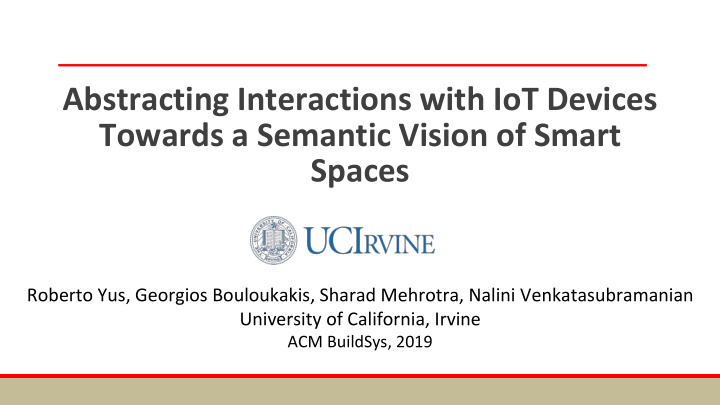



Abstracting Interactions with IoT Devices Towards a Semantic Vision of Smart Spaces Roberto Yus, Georgios Bouloukakis, Sharad Mehrotra, Nalini Venkatasubramanian University of California, Irvine ACM BuildSys, 2019
IoT Application Development People’s - Constrained to specific devices/protocols world -Difficult to port to other IoT spaces -Developer needs to understand the devices in the IoT space which makes development challenging Device’s world
IoT Application Development People’s world App request: ➢ “ Decrease temperature of rooms with Device’s occupancy above 50% of their capacity .” world User/Space policy: ➢ “ Do not capture the location of John and Mary when they are in their offices .”
Challenge: Semantic Gap People’s world SEMANTIC GAP App request: ➢ “ Decrease temperature of rooms with Device’s occupancy above 50% of their capacity .” world User/Space policy: ➢ “ Do not capture the location of John and Mary when they are in their offices .” Which sensors/actuators can we use to answer such request/policy?
Challenge: IoT Heterogeinity Dozens of devices in the market! SEMANTIC GAP Device’s world https://www.postscapes.com/iot-thermostats/ … Different interaction paradigms and communication protocols https://iotbyhvm.ooo/what-is-coap-protocol/
SemIoTic: End-to-End IoT Framework People’s world SemIoTic Device’s world App request: ➢ “ Decrease temperature of rooms with occupancy above 50% of their capacity .” 1) Translate people’s world request into device’s world request 2) Communicate with specific devices using their protocols
Architecture Extensible metamodel to define IoT smart spaces
Modeling IoT Spaces ● Defining IoT spaces using an ontology provides flexibility and extensibility . ○ In addition, semantic reasoning to infer non-explicitly defined information (e.g., if occupancy is a property of rooms, it should be also of meeting room 2065 ). ● Created OWL meta ontology (semic) extending the popular sensor ontology ( SSN/SOSA ) ○ Focus on representing the connection between “people’s world” and “device’s world” . ■ Properties of people/spaces (e.g., location, occupancy, temperature) connected to sensors/actuators based on expected value types and produced value types.
Architecture Based on domain model applications pose actions (i.e., requests, commands, or policies)
Defining User Actions ● User Actions (UA) , expressed at the semantic-level: ○ Requests for data (UR) ○ Commands (UC) ○ Policies (UP) ● Language for definition of general UAs with following elements: ○ Entities of interest (E) → Set of entities e i , either entity classes ⟨ e i ,rdfs:subClassOf,semic:Entity ⟩ or entity instances ⟨ e i ,rdf:type,semic:Entity ⟩ ○ Properties of interest (P) → Set of properties p i ⟨ p i , rdf:type,semic:Property ⟩ . ○ Conditions (C) → expression containing properties that has to be satisfied to perform the actions on the entities ○ (For UP) Interaction to control (i.e., capture,store, share) and preferred action (i.e., accept or deny). ⟨ <Mary, John>, Location ⟩ UR “retrieve the current location of John and Mary” UC “decrease temp. of rooms with occ. above 50% of their capacity” ⟨ Room, ControlTemp, Occupancy>0.5xCapacity ⟩ UP “do not capture Mary’s and John’s location in private spaces when ⟨ <Mary, John>, Location subClassOf PrivateSpace, Location.Occupancy<2, capture, deny ⟩ the occupancy is less than 2 people”
Architecture User Actions get translated into Device- level Actions
Translating User Actions ● Goal: ○ Create a plan involving IoT devices to process a UA. ● Ontology-based translation algorithm that can process policies as well as requests/commands defined at a higher-level. UA User Action Translation Plans can be infeasible if sensors are not 1) Flattening available (e.g., due to 2) Plan Generation privacy policies) 3) Realizability Checking 4) Feasibility Checking Selection based on 5) Plan Selection metrics (e.g., economical cost, latency, reliability)
Architecture Device-Actions get implemented on sensors/actuators based on their features (e.g., communication protocol).
Device Action Handling CoAP WRAPPER Camera1 Camera2 Wrapper Request Consumer Handler Builder Connector Provider CoAP WebSocket Connector Connector SemIoTic WebSocket WebSocket REST GPS1 Bluetooth Connector Connector Beacon1 ... MQTT Response Connector Builder MQTT WiFi WiFi 1 2 Software components pre-built. To develop wrapper for specific device, developer just includes information about: underlying protocol, parameter, data conversion.
Using SemIoTic Web application to show occupancy related information of the smart space Wrappers for different sensors (e.g., Domain models for a Smart University Raspberry PI camera, SkySpark building and a Smart Home HVAC)
Using SemIoTic Same application and same request but different underlying sensors used by SemIoTic SemIoTic (Smart Building) SemIoTic (Smart Home) Reduction of development effort (in terms of LoC) by 55% to 97%
Thanks!
Recommend
More recommend